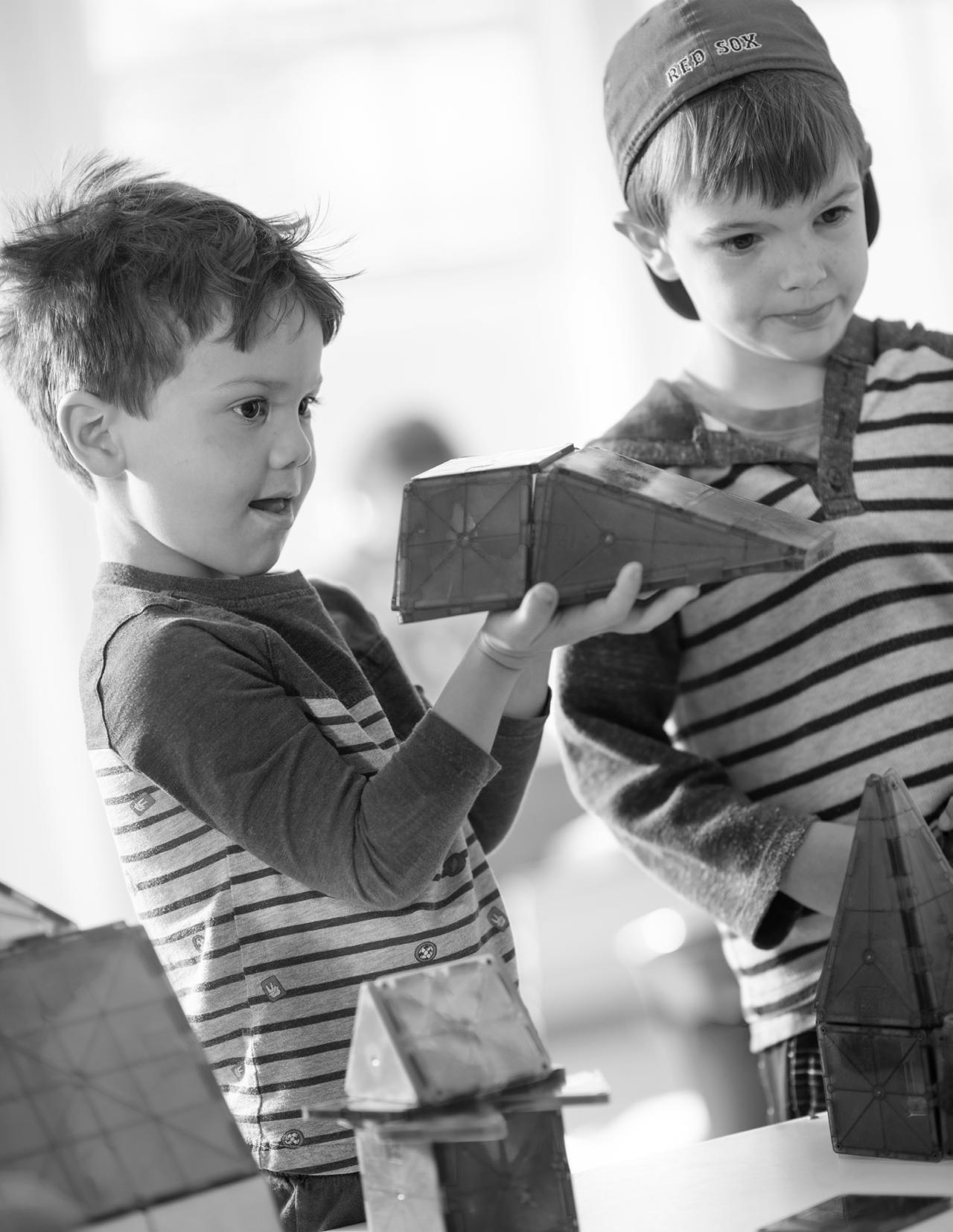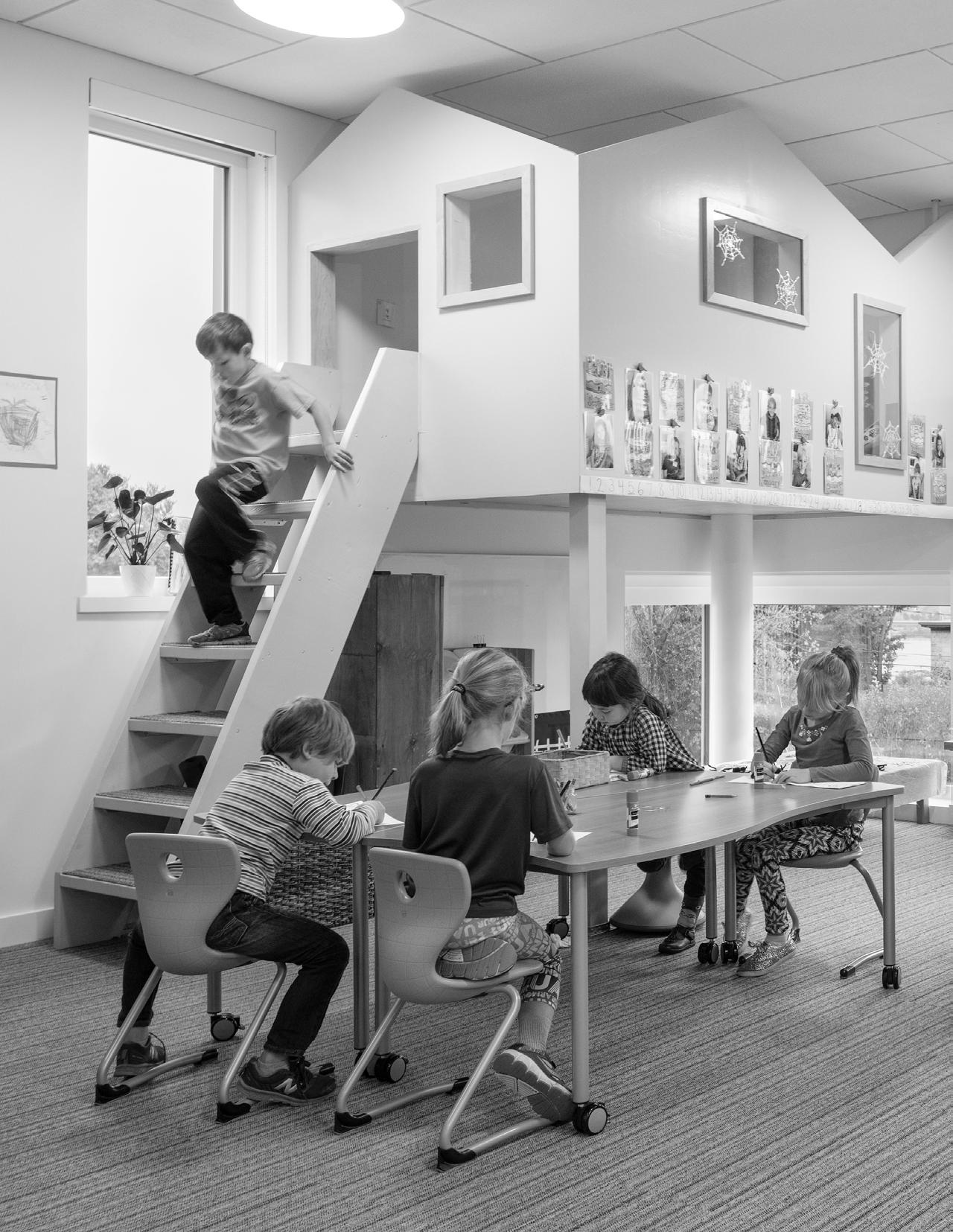
4 minute read
Early Childhood
The Early Childhood program (ages 3–5) promotes positive growth for young children through active play and focused inquiry. We aim to ensure that a child’s initial exposure to school is a positive and happy one. The Early Childhood program is deeply rooted in the Reggio Emilia approach. Students and teachers collaborate to shape the curricular studies each year. Through our emergent thematic studies, students develop skills in social-emotional learning, mindfulness, literacy, numeracy, science, visual arts, performing arts, and music.
Language Arts
Advertisement
Listening enjoy stories, poetry, rhyming, and playing with sounds of language, listen and respond appropriately to others, follow multistep directions, match letters to sounds, and hear and remember stories and other information.
Speaking exhibit ability to verbalize needs, recite songs and poetry with the group and/or independently, share ideas and experiences, dictate stories with a beginning, middle, and end, and join discussions with relevant comments and questions.
Reading enjoy stories and poetry, identify their own names in print, begin to identify letter names and sounds, and strengthen receptive and expressive vocabulary.
Writing express ideas through drawing, dictate stories, develop fine motor skills, develop a functional pencil grip, and begin to develop correct letter formation.
Mathematics
Number Sense understand that numbers have many uses (e.g., recipes, prices, ages), count from 1 to 10, begin to recognize numerals and understand what numbers mean (e.g., the numeral 5 stands for five), and count using one-to-one correspondence. Computation begin to use varied manipulative materials purposefully, and gain experience with and exposure to beginning addition and subtraction.
Data Analysis gather and help organize information, and sort and classify objects by attributes.
Geometry describe, model, and classify shapes.
Measurement gain experience with concepts of length, weight, and volume.
Patterns and Relationships recognize, describe, and create simple patterns, and begin to understand calendar concepts.
Math Communications express awareness of attributes such as size, shape, and quantity, help use a procedural list such as a recipe, and begin to print numerals.
Social Studies
recognize unique individual strengths and explore family backgrounds, honor a broad range of diversity, understand how members of a community help each other, identify and practice rights and responsibilities of group membership, and utilize maps, globes, and research materials to learn about and honor traditions from various cultures.
Science
Life Science develop appreciation for the environment and learn ways to help preserve it, observe and compare different types of plants and animals, study the habitats and life cycles of various life forms, observe the development of plants over time, use science tools such as magnifying glasses to aid observation, and investigate how seasonal changes affect living things.
Physical Science study the relative properties of various materials through experience with sand, water, play dough, clay, etc., use scales to experiment with and develop the concept of balancing, explore magnetism by experimenting with magnets to determine their properties, experience physical changes in ingredients during cooking projects, design and assemble structures and environments using a variety of natural and man-made materials, and study the relationships among light, objects, and shadows.
Visual Arts
Creative Expression understand that visual arts may be used to express observations, ideas, understandings, or emotions, begin to understand that materials may be chosen for specific purposes, draw with a variety of graphic materials, paint with tempera, watercolor, and finger paint, demonstrating a variety of marks, identify primary, secondary, and neutral colors by name, and experiment with mixing colors, begin to explore the concept of uniting small parts to form a larger whole, begin to represent people and objects in two and three dimensions with a variety of media, and explore light and transparency as vehicles for selfexpression.
Aesthetics describe their own work, and look carefully to notice details.
Arts and Cultural Heritage know that all people create art differently, and know that art is made from many different materials.
Music
keep a steady pulse, use motions with songs, distinguish between high and low pitches, match pitches, begin to develop head voice, experiment with a variety of instruments and sound sources, perform simple beats on percussion instruments, create songs by combining original words and melodies, and include music in creative play. Creative Movement
communicate concepts and ideas through movement, develop freedom of movement and expression with and without limitations, relate movement explorations in the dance space to classroom themes of study, develop a sense of physical well-being and flexibility, strengthen muscular coordination and motor skills, and develop basic locomotor and axial movements in isolation and combination.
Physical Education
identify physical changes that occur during vigorous activity, perform appropriate warm-up activities, engage in moderate to vigorous physical activity, learn basic elements of movement, move with an awareness of space and others’ safety, develop locomotor skills (e.g., running, jumping, galloping), build non-locomotor skills (e.g., bending, stretching, rolling), improve form with sports equipment (e.g., balls, beanbags, paddles), identify the rules of a given activity, demonstrate the ability to cooperate with peers, and use equipment responsibly.
Health
demonstrate independence in basic self-help and personal hygiene skills, differentiate between safe and harmful substances found at home and school, apply coping strategies when feeling overly excited, anxious, or angry, and demonstrate healthy ways to express needs, wants, and feelings.
Spanish
Students in Early Childhood are exposed to Spanish primarily through books, songs, and games. Class occurs once a week in the format of a general meeting, where students and advisors are encouraged to participate in a variety of activities in Spanish.





